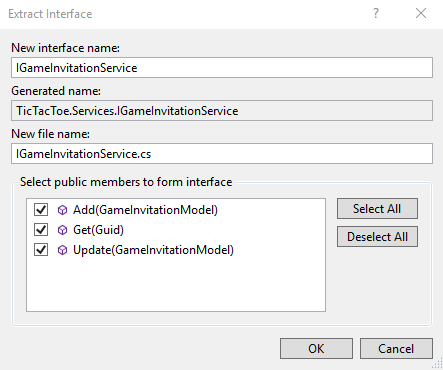In the following example, you are going to add a new service for handling game invitations and updating the Tic-Tac-Toe application. This facilitates email communication, which is used for contacting other users to join a game, while using method injection:
- Add a new service called GameInvitationService in the Services folder for managing game invitations (adding, updating, removing, and more):
public class GameInvitationService
{
private static ConcurrentBag<GameInvitationModel>
_gameInvitations;
public GameInvitationService(){ _gameInvitations = new ConcurrentBag<GameInvitationModel>();}
public Task<GameInvitationModel> Add(GameInvitationModel
gameInvitationModel)
{ gameInvitationModel.Id = Guid.NewGuid();
_gameInvitations.Add(gameInvitationModel);
return Task.FromResult(gameInvitationModel); }
public Task Update(GameInvitationModel gameInvitationModel)
{ _gameInvitations = new ConcurrentBag<GameInvitationModel>
(_gameInvitations.Where(x => x.Id != gameInvitationModel.Id))
{ gameInvitationModel };
return Task.CompletedTask; }
public Task<GameInvitationModel> Get(Guid id)
{ return Task.FromResult(_gameInvitations.FirstOrDefault(x =>
x.Id == id)); }
}
- Extract the IGameInvitationService interface:

- Add the new game invitation service to the ConfigureServices method of the Startup class (we want a single application instance, so add it as a singleton):
services.AddSingleton<IGameInvitationService,
GameInvitationService>();
- Update the Index method in GameInvitationController and inject an instance of the game invitation service via method injection using the RequestServices provider:
public IActionResult Index(GameInvitationModel gameInvitationModel, [FromServices]IEmailService emailService)
{
var gameInvitationService = Request.HttpContext.RequestServices.GetService <IGameInvitationService>();
if (ModelState.IsValid) {
emailService.SendEmail(gameInvitationModel.EmailTo,
_stringLocalizer["Invitation for playing a Tic-Tac-Toe game"],
_stringLocalizer[$"Hello, you have been invited to play the
Tic-Tac-Toe game by {0}. For joining the game, please
click here {1}", gameInvitationModel.InvitedBy,
Url.Action("GameInvitationConfirmation", GameInvitation",
new { gameInvitationModel.InvitedBy,
gameInvitationModel.EmailTo }, Request.Scheme,
Request.Host.ToString())]);
var invitation = gameInvitationService.Add
(gameInvitationModel).Result;
return RedirectToAction("GameInvitationConfirmation",
new { id = invitation.Id }); }
return View(gameInvitationModel);
}
Don't forget to add the following using statement at the beginning of the class: using Microsoft.Extensions.DependencyInjection;, If you don't, the .GetService<IGameInvitationService>(); method can't be used and you will get build errors.
- Add a new method called GameInvitationConfirmation to GameInvitationController:
[HttpGet]
public IActionResult GameInvitationConfirmation(Guid id,
[FromServices]IGameInvitationService gameInvitationService)
{
var gameInvitation = gameInvitationService.Get(id).Result;
return View(gameInvitation);
}
- Create a new view for the GameInvitationConfirmation method you added previously. This will display a waiting message to the user:
@model TicTacToe.Models.GameInvitationModel
@{
ViewData["Title"] = "GameInvitationConfirmation";
Layout = "~/Views/Shared/_Layout.cshtml";
}
<h1>@Localizer["You have invited {0} to play
a Tic-Tac-Toe game
with you, please wait until the user is connected",
Model.EmailTo]</h1>
@section Scripts{
<script>
$(document).ready(function () {
GameInvitationConfirmation('@Model.Id');
});
</script>
}
- Add a new method called GameInvitationConfirmation to the scripts1.js file. You can use the same basic structure we used for the existing EmailConfirmation method:
function GameInvitationConfirmation(id) {
if (window.WebSocket) {
alert("Websockets are enabled");
openSocket(id, "GameInvitation");
}
else {
alert("Websockets are not enabled");
interval = setInterval(() => {
CheckGameInvitationConfirmationStatus(id);
}, 5000);
}
}
- Add a method called CheckGameInvitationConfirmationStatus to the scripts2.js file. You can use the same basic structure we used for the existing CheckEmailConfirmationStatus method:
function CheckGameInvitationConfirmationStatus(id) {
$.get("/GameInvitationConfirmation?id=" + id,
function (data) {
if (data.result === "OK") {
if (interval !== null)
clearInterval(interval);
window.location.href = "/GameSession/Index/" + id;
}
});
}
- Update the openSocket method in the scripts2.js file and add the specific game invitation case:
...
if (strAction == "Email") {
wsUri = protocol + "//" + window.location.host + "/CheckEmailConfirmationStatus";
operation = "CheckEmailConfirmationStatus";
}
else if (strAction == "GameInvitation") {
wsUri = protocol + "//" + window.location.host + "/GameInvitationConfirmation";
operation = "CheckGameInvitationConfirmationStatus";
}
var socket = new WebSocket(wsUri);
socket.onmessage = function (response) { console.log(response);
if (strAction == "Email" && response.data == "OK") {
window.location.href = "/GameInvitation?email=" + parameter;
}else if (strAction == "GameInvitation") {
var data = $.parseJSON(response.data);
if (data.Result == "OK") window.location.href = "/GameSession/Index/" + data.Id; } };
...
- Add a new method called ProcessGameInvitationConfirmation in the communication middleware. This will process game invitation requests without using WebSockets for browsers that don't support this feature:
private async Task ProcessGameInvitationConfirmation(HttpContext context)
{
var id = context.Request.Query["id"];
if (string.IsNullOrEmpty(id))await context.
Response.WriteAsync("BadRequest:Id is required");
var gameInvitationService = context.RequestServices.GetService
<IGameInvitationService>();
var gameInvitationModel = await
gameInvitationService.Get(Guid.Parse(id));
if (gameInvitationModel.IsConfirmed) await
context.Response.WriteAsync(
JsonConvert.SerializeObject(new
{
Result = "OK",
Email = gameInvitationModel.InvitedBy,
gameInvitationModel.EmailTo
}));
else {
await context.Response.WriteAsync(
"WaitGameInvitationConfirmation");
}
}
Don't forget to add the following using statement at the beginning of the class:
using Microsoft.Extensions.DependencyInjection;.
using Microsoft.Extensions.DependencyInjection;.
- Add a new method called ProcessGameInvitationConfirmation with additional parameters to the communication middleware. This will process game invitation requests while using WebSockets for the browsers that support this:
private async Task ProcessGameInvitationConfirmation(HttpContext context,
WebSocket webSocket, CancellationToken ct,
string parameters) { var gameInvitationService = context.RequestServices.GetService
<IGameInvitationService>(); var id = Guid.Parse(parameters); var gameInvitationModel = await gameInvitationService.Get(id); while (!ct.IsCancellationRequested && !webSocket.
CloseStatus.HasValue &&
gameInvitationModel?.IsConfirmed == false) {
await SendStringAsync(webSocket, JsonConvert.
SerializeObject(new { Result = "OK", Email = gameInvitationModel.InvitedBy,
gameInvitationModel.EmailTo, gameInvitationModel.Id }), ct); Task.Delay(500).Wait(); gameInvitationModel = await gameInvitationService.Get(id); } }
- Update the Invoke method in the communication middleware. This will work with email confirmations and game invitation confirmations from now on, with and without WebSockets:
public async Task Invoke(HttpContext context)
{
if (context.WebSockets.IsWebSocketRequest)
{
...
switch (command.Operation.ToString())
{
...
case "CheckGameInvitationConfirmationStatus":
{ await
ProcessGameInvitationConfirmation(context,webSocket, ct,
command.Parameters.ToString());
break; }
}
}
else if (context.Request.Path.Equals
("/CheckEmailConfirmationStatus"))
{ await ProcessEmailConfirmation(context); }
else if (context.Request.Path.Equals
("/CheckGameInvitationConfirmationStatus"))
{ await ProcessGameInvitationConfirmation(context); }
else { await _next?.Invoke(context); }
}
In this section, you have learned how to use method injection in your ASP.NET Core 3 web applications. This is the preferred method for injecting your services and you should use it whenever applicable.
You have advanced well with the implementation of the Tic-Tac-Toe game. Mostly everything around user registration, email confirmation, game invitation, and game invitation confirmation has now been implemented.
